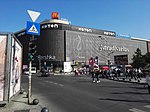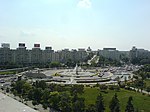Piața Unirii metro station

Piața Unirii (Union Square) is a major metro station in Bucharest. It is located in the southern part of the city centre, in Union Square (Piața Unirii in Romanian), and it is one of the busiest stations of the Bucharest Metro. It is made up of two terminals, one on the M1 and M3 lines and another on the M2 line, linked by a passage. The M1/M3 station was opened on 19 November 1979 as part of the inaugural section of Bucharest Metro, between Semănătoarea and Timpuri Noi. The M2 station was opened on 24 January 1986 as part of the inaugural section of the line, from Piața Unirii to Depoul IMGB. On 24 October 1987, the line was extended north to Pipera.A McDonald's fast-food restaurant is located in the vestibule above the M2 line platform. The station also features kiosks selling from newspapers to stationery, bakeries, a diversity of shops, public phones, a large transport police station (with a list of mugshots at the entrance) and mobile-phone servicing points. Due to the numerous entrances located in and around Piața Unirii square to the two metro terminals that make up the entire Piața Unirii station, it is located in Sectors 2, 3, 4, and 5 of Bucharest. The original entrances, opened in 1979 were shut off and replaced by newer ones around 1987, due to the reconstruction of the square. Nowadays some of them serve as service entrances, and from above-ground, they can be noticed by a narrow metal door.
Excerpt from the Wikipedia article Piața Unirii metro station (License: CC BY-SA 3.0, Authors, Images).Piața Unirii metro station
Pasajul Pietonal Metrou Unirii, Bucharest Centrul Civic (Sector 3)
Geographical coordinates (GPS) Address Nearby Places Show on map
Geographical coordinates (GPS)
| Latitude | Longitude |
|---|---|
| N 44.42774 ° | E 26.10417 ° |
Address
Piața Unirii 2
Pasajul Pietonal Metrou Unirii
030119 Bucharest, Centrul Civic (Sector 3)
Romania
Open on Google Maps










